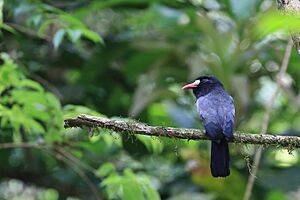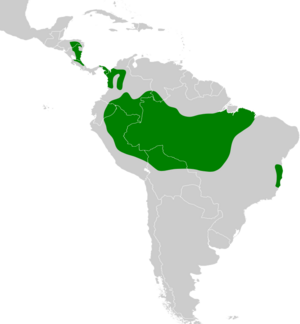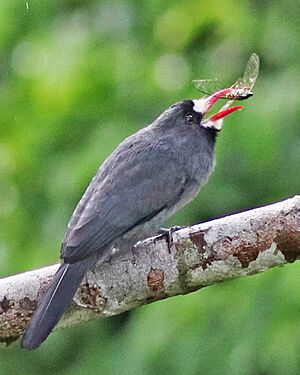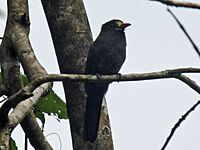White-fronted nunbird facts for kids
Quick facts for kids White-fronted nunbird |
|
|---|---|
 |
|
| Conservation status | |
| Scientific classification | |
| Genus: |
Monasa
|
| Species: |
morphoeus
|
 |
|
The white-fronted nunbird (Monasa morphoeus) is a cool type of bird found in many countries. These include Bolivia, Brazil, Colombia, Costa Rica, Ecuador, Honduras, Nicaragua, Panama, Peru, and Venezuela. It belongs to a bird family called Bucconidae, which includes puffbirds and nunlets.
Contents
Bird Families and Types
Birds are grouped into families and types, much like how your family might have different branches. The white-fronted nunbird has seven main types, called subspecies. These subspecies are slightly different from each other.
Some of these types were once thought to be completely separate birds. Also, the white-fronted nunbird is very closely related to the black-fronted nunbird and the black nunbird. They are often grouped together as a "superspecies" because they are so similar.
What Does It Look Like?
The white-fronted nunbird is about 21 to 29 centimeters (8 to 11 inches) long. That's about the length of a ruler! Their weight can vary, from about 63 to 101 grams (2.2 to 3.6 ounces).
Most of these birds are a dark grayish-black color. Their belly area is a bit grayer. The most special part of their look is their white forehead and chin. Their beak is a bright orange-red, their eyes are brown, and their legs are black. Young nunbirds have a buffy-reddish face. Their body feathers also look a bit brownish.
Different types of white-fronted nunbirds can vary in size. They also differ in how dark their feathers are and how much white they have on their face. Birds living in the northern parts of their range are usually bigger than those in the south.
Where Do They Live?
White-fronted nunbirds live in many different places across Central and South America. You can find them in eastern Honduras, Nicaragua, Costa Rica, and Panama. They also live in parts of Colombia, Ecuador, Peru, Bolivia, and Brazil. Some are even found in Venezuela.
These birds like to live in different kinds of forests. This includes lowland rainforests and forests along rivers. They can also be found in areas where some trees have been cut down. Sometimes, they live in shaded cocoa farms or old clearings with scattered trees. They usually live in lower areas, but in some countries, they can be found higher up in the mountains.
How They Live: Behavior
What They Eat
The white-fronted nunbird mainly eats insects. But they also enjoy other small creatures like spiders and scorpions. Sometimes, they even eat small lizards, amphibians, and fruits.
These clever birds often follow groups of monkeys or swarms of army ants. They also follow flocks of other birds like caciques and oropendolas. Why? Because these animals stir up insects and other prey, making it easier for the nunbirds to catch their food!
Life Cycle and Reproduction
White-fronted nunbirds build their nests in tunnels. They dig these tunnels in flat or sloped ground. At the end of the tunnel, they make a small room lined with leaves.
In Costa Rica, they lay eggs between December and May. In Colombia, it's from February to May. A mother nunbird usually lays two or three eggs. Both parents, and sometimes up to six adult birds, help take care of the eggs and the young birds.
What Sounds They Make
The white-fronted nunbird has many different calls. One sound is a soft, falling whistle that ends with a short, rippling trill. It sounds like "peeeur-r-r-r-r." They also make a loud, sad "how how how" sound. You might also hear them make rippling trills, churrs, and rattles. Sometimes, groups of them will sing together in loud gobbling and barking sounds.
How Are They Doing?
The IUCN (International Union for Conservation of Nature) has looked at the white-fronted nunbird. They have decided that this bird is of "Least Concern." This means they are not currently in danger of disappearing.
The white-fronted nunbird lives in a very large area. There are at least five million adult birds, which is a lot! However, their numbers are slowly going down. In some places, they are common, while in others, they are harder to find.
Gallery




